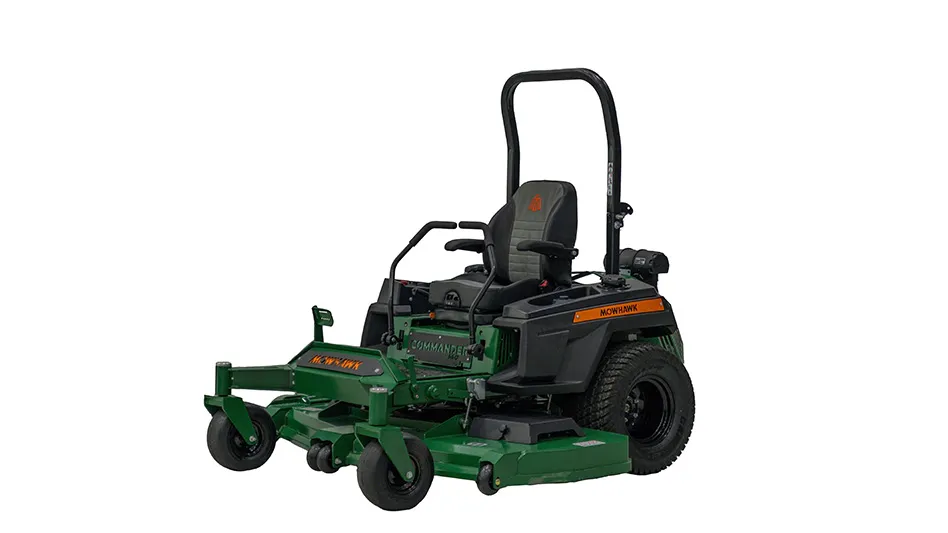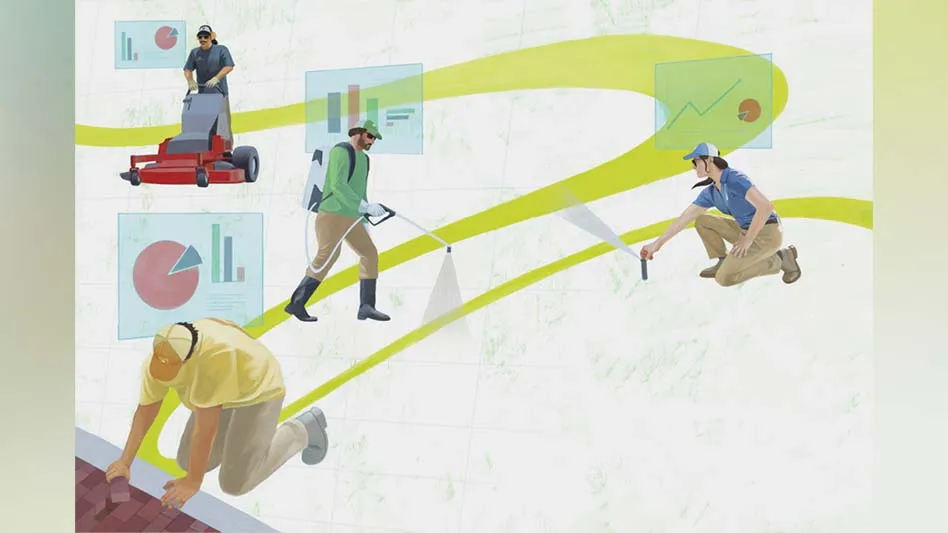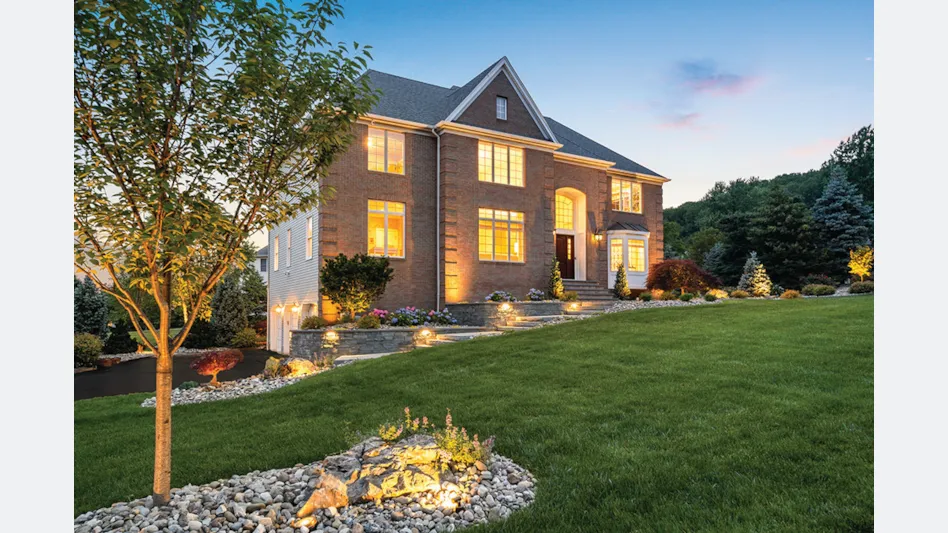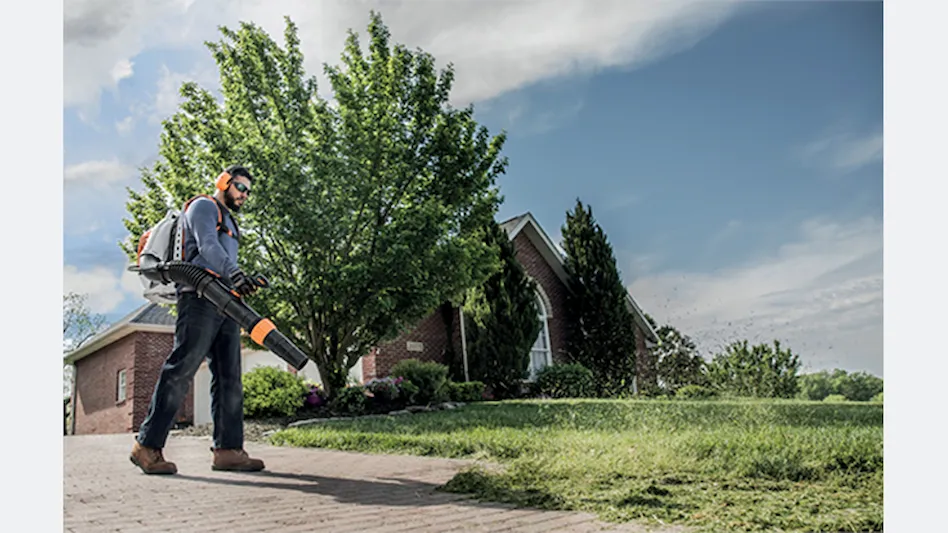
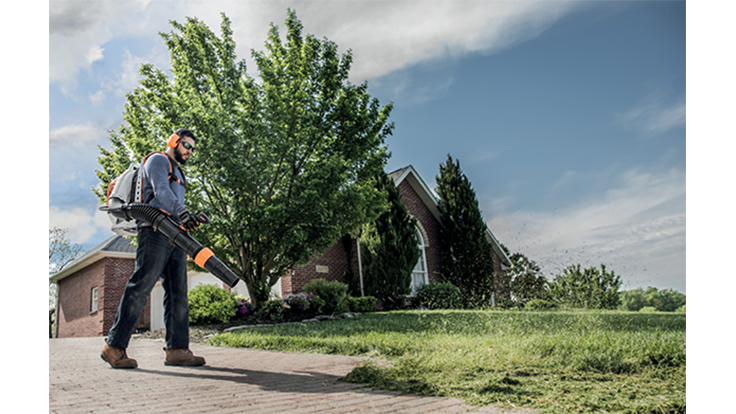
In the last few years, better design and lightweight materials have helped improve the overall weight of backpack blowers.
Whether you’re clearing off residential driveways and walks after mowing or keeping large commercial properties clean, blowers are indispensable tools of the trade. The right blower helps you leave a clean sweep with a minimum of effort, improving crew productivity and reducing fatigue. While vacuum technology has remained relatively unchanged in recent years, many companies have introduced improved blower features in the past year or two to help you get jobs done faster and more efficiently.
If you’re thinking of upgrading your blower or adding to your equipment lineup, here are the latest improvements to consider when shopping:
Control features.
No one has time for multiple passes over the same ground; that’s where new efficiency elements come into play. “We’ve got a lot to benefit commercial contractors, especially for large properties,” says Allen Baird, product marketing manager for Cub Cadet. “For example, with our 180-degree electric swivel nozzle, you can blow a large volume of debris left and right by rotating the nozzle from the operator’s station.” This prevents having to backtrack.
Adjustable airflow is another benefit on new Cub Cadet units. “If you’ve got a lot of bulk fluffy leaves, you can open up that air flow and blow into the woods,” Baird says. “Or you can dial it down to slow down that flow if you don’t want to blow debris into a vehicle, or you need to quiet it down.” This adjustability also allows maximum control so you won’t disturb mulched areas and planting beds.
Maneuverability is another concern. A self-propelled unit is always welcome, especially if you deal with a lot of hilly terrain. But sometimes a simple feature, such as the locking front wheel on some units, can be helpful. “With all that air flow, it could push the machine one way or another,” Baird says. “But when you can lock the front wheel, you can blow straight or you can disengage and let the wheel float around edges, which helps you steer.”
Ride-on platforms are another option. Steiner has introduced an out-front turbine blower attachment that can be driven at 2 to 3 times the pace of someone walking behind a blower. That can present real savings for productivity and prevent operator fatigue when blowing large areas such as athletic fields, parks or estate properties.
Performance features.
Power is something that’s always being tweaked. Everyone always wants the most powerful blower to get jobs done faster, and manufacturers have stepped it up on all levels. Handheld and backpack blowers now range from around 400 to 900 cfm, while self-propelled walk-behinds or tractor attachments range from 2,400 to 8,000 cfm.
Another issue for handheld and backpack blowers is weight. In the last few years, better design, including the use of more lightweight materials, has improved the overall weight of backpack blowers. “Our latest model has a 25 percent larger engine with 35 percent increased blower performance at exactly the same weight as earlier models,” says Jason Wilk, product manager for ECHO.
Weight was held steady due to the use of carbon fiber technology for constructing the housing and frame of the unit instead of the standard plastic. “This material has been used in the automotive industry, but this is the first time it’s been used for outdoor power equipment,” Wilk says.
As some municipalities crack down on noise ordinances within city limits, manufacturers are striving to lower decibel levels across the board on all types of blowers. Some manufacturers have “low-noise” units that come in around 58 to 65 decibels (dB), which is often the max allowable level in restricted areas. Standard blowers typically run at 75 to 80 dB.
Ease of use.
One of the most popular advancements STIHL recently introduced is its side start on backpack blowers. “We listened to landscaper feedback, and our engineers developed a way to let you start and restart the unit while keeping the unit on your back,” says Thomas Techow, product manager at STIHL. “You don’t have to take the backpack off. It’s really exceeded our expectations in terms of popularity.”
Another essential issue is user comfort. STIHL offers adjustable ergonomically-designed S-shaped shoulder straps, as well as a hip belt and chest strap. “The backpack shifts the weight so it’s better distributed between the hips and shoulders and not just on your arms,” Techow says.
Battery-powered equipment.
Some manufacturers offer battery-powered equipment as an alternative for gas-powered. One of the benefits is reduced noise. In fact, one of STIHL’s lithium-ion powered units comes in at 56 dB. A new design also shifts battery weight from the unit to the back or hip with a cable connecting system to reduce user fatigue.
Other manufacturers are following suit in the battery-operated segment of the market. “We’ve designed a line of battery-powered outdoor equipment that delivers the power of professional gas equipment with an all-day run time and quieter operation,” says Sarah Hohmann, brand manager for EGO.
EGO’s new commercial series features a backpack battery, that weighs about 20 pounds. It’s used with a handheld blower, which weighs less than six pounds. Another benefit: The rapid recharge option takes the battery from zero to 100 percent in 3.5 hours.
Keep it down: Manufacturers are designing blowers to produce less noise as cities create noise ordinances.
Shopping tips.
If you’re in the market for a new blower, do a reality check about how you use this equipment on a daily basis. A handheld may be fine for small areas or infrequent use, but a backpack is more efficient for daily use. If you’re maintaining large commercial accounts, a self-propelled unit or a blower attachment used with a tractor may be a better choice. Most manufacturer sites have product selector guides online to walk you through your options, or talk to your dealer.
Another factor to consider when buying is your relationship with a dealer.
“Service is important,” Techow says. “You need a good network in case you run into an issue. Ask how fast a dealer can get maintenance work done or how fast they typically can get parts, for example. You don’t want down time.”
What’s ahead?
As manufacturers continue to strive for improvements in control, performance and ease of use, what else can we expect in terms of further advancements? It’s likely that as more municipalities enforce noise bans, landscape contractors will have to adapt new technologies, such as the use of quieter blowers.
Another likely trend is increased connectivity. It’s no secret that the world is becoming more and more connected.
“We’re looking at technology incorporated into everything we do and everything we use today,” says Wilk from ECHO. “It’s my opinion we’ll see technologies such as 5G and Bluetooth become more and more integrated into the handheld power equipment segment.”

Explore the August 2019 Issue
Check out more from this issue and find you next story to read.

